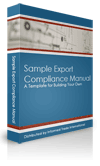Developments Regarding The Deemed Export Rule
Developments Regarding The “Deemed Export†Rule
Within the panoply of governmental strictures encompassing the American export control world, two foundational legislative planks are the Export Administration Regulations (EAR) and the International Traffic in Arms Regulations (ITAR). The ITAR imposes specific requirements and restrictions on how corporations may conduct business in the international marketplace even before a license has been approved. The Department of State’s involvement in regulating export control activity is fundamentally a function of furthering foreign policy and national security interests. As such, all permanent or temporary exports of defense articles; related technical data; and the performance of defense services by a U.S. person to a foreign person, individual, company or government, require the correct usage of licenses or license exceptions. The EAR regulates the export of “dual use†items or inherently non-defense products and data, and is administered and controlled by the Department of Commerce. Exports usually encompass the physical transfers of goods to locations outside of the U.S. However, in addition to goods, the export of technology or software source code (exception being encryption source code) is “Deemed” to take place when it is released to a foreign national within the United States. (See §734.2(b)(2)(ii) of the EAR). Deemed exports refer to the transfer of sensitive dual-used technologies to foreign nationals working or studying in the United States.
Any foreign national is subject to the “deemed export” rule except a foreign national who (1) is granted permanent residence, as demonstrated by the issuance of a permanent resident visa (i.e., “Green Card”); or (2) is granted U.S. citizenship; or (3) is granted status as a “protected person” under 8 U.S.C. 1324b(a)(3). This includes all persons in the U.S. as tourists, students, businesspeople, scholars, researchers, technical experts, sailors, airline personnel, salespeople, military personnel, and diplomats. As noted, one exception to this general statement is a “protected person.” “Protected persons” include political refugees and political asylum holders. Be aware that individuals seeking “protected person” status must satisfy all of the terms and conditions that are fully set forth in 8 U.S.C. 1324b(a)(3). It should be emphasized that although the deemed export rule may be triggered; this does not necessarily mean that a license is required. For example, the technology may be EAR99 or license exception eligible. Technology may be “released” for export when it is available to foreign nationals for visual inspection (for example, reading technical specifications, plans, blueprints, etc.); when technology is exchanged orally; or when technology is made available by practice or application under the guidance of persons with knowledge of the technology. Per Part 772 of the Export Administration Regulations (EAR), “technology” is specific information necessary for the “development,” “production,” or “use” of a product.
Several developments in the field of deemed exports have occurred recently. The Commerce Department has now formed an Advisory Committee to help it revise rules on deemed exports of sensitive dual-use technologies. The government would like to revise the current rules because foreign researchers are playing a growing role in technology research and development. Norman Augustine, former CEO of Lockheed Martin Corp. and chairman of an advisory committee on deemed exports, delivered the panel’s report three months ago. It has been under review since then by the Bureau of Industry and Secretary (BIS). “U.S. deemed export policy must account for the variety of risks we face,” Mario Mancuso, Undersecretary of Commerce for industry and security, said in a statement on Feb. 6, 2008. “While our rules should not permit the transfer of sensitive U.S. technology to a real or potential adversary, they must ensure the United States remains the most innovative and competitive economy in the world.” But critics of the report said it doesn’t reflect the many adverse comments the advisory committee received about proposed changes to U.S. deemed export rules. Last June, the agency dropped plans to tighten restrictions on foreign researchers working in the U.S. The restrictions were being pushed by the Defense Department. At the time, universities and research groups vigorously opposed the plan. Mancuso said the Commerce Department is now working with Pentagon officials along with bureaucrats at the departments of State and Energy on how to reform U.S. deemed export rules.
So what are the business implications for your company? Corporate employees have frequent contact with foreign nationals, such as at social or professional interactions; when attending conferences; and through the exchange of written material by email, facsimile transmissions, and reports. Through these contacts, employees are precluded from communicating or transmitting technical data. Your corporation must educate its employees about the risks of unauthorized release of information. Potential risks include: financial penalties; possible prison sentences; and loss of export privileges by the Departments of Commerce and State. The more attention your company pays to the deemed export rule, the stronger your internal export control regime will become and the risk of violation will be significantly reduced.
Contributed by:
Jarred A. Fishman, Export Coordinator ES
Lockheed Martin Corporation
April 2008
Posted on April 2nd, 2008 by keeton
Filed under: ITAR

